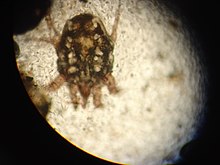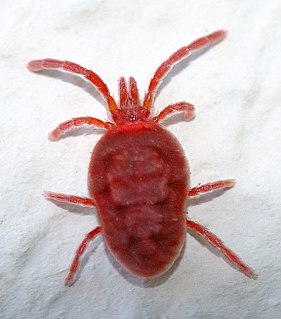
Mites are small arachnids.

The Acari are a taxon of arachnids that contains mites and ticks. The diversity of the Acari is extraordinary and their fossil history goes back to at least the early Devonian period. Acarologists have proposed a complex set of taxonomic ranks to classify mites. In most modern treatments, the Acari are considered a subclass of the Arachnida and are composed of two or three superorders or orders: Acariformes, Parasitiformes, and Opilioacariformes; the latter is often considered a subgroup within the Parasitiformes. The monophyly of the Acari is open to debate, and the relationships of the acarines to other arachnids is not at all clear. In older treatments, the subgroups of the Acarina were placed at order rank, but as their own subdivisions have become better understood, treating them at the superorder rank is more usual.

Varroa jacobsoni is a species of mite that parasitises Apis cerana. The more damaging Varroa destructor was previously included under the name V. jacobsoni, but the two species can be separated on the basis of the DNA sequence of the cytochrome oxidase I gene in the mitochondrial DNA.

Hylomys is a small genus of the family Erinaceidae. Hylomys species, like all species in the subfamily Galericinae, are known as gymnures or moonrats. Their closest relatives include the fossil Lantanotherium and Thaiagymnura and the living Neotetracus and Neohylomys.

The Acariformes, also known as the Actinotrichida, are the most diverse of the two superorders of mites. Over 32,000 described species are found in 351 families, and an estimated total of 440,000 to 929,000 species occur, including undescribed species.

Feather mites are the members of diverse mite superfamilies:
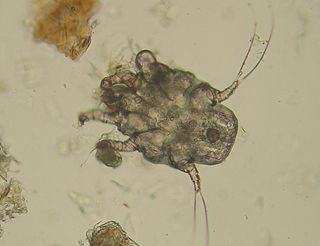
Astigmatina is a cohort of mites in the subclass Acari, mites and ticks. Astigmata has been ranked as an order or suborder in the past, but was lowered to the cohort Astigmatina of the supercohort Desmonomatides in the suborder Oribatida, of the order Sarcoptiformes. Astigmatina is now made up of the two groups Acaridia and Psoroptidia, which have been suborders of the order Astigmata in the past. Astigmatina contains about 10 superfamilies and 76 families under Acaridia and Psoroptidia.

The Proctophyllodidae are a family of the Acarina (mite) order Astigmata. They contain many feather mites. The Alloptidae and Trouessartiidae were in earlier times included here as subfamilies.

Histiostomatidae is a family of astigmatid mites and branches basically in a phylogenetic tree of the Astigmata.
The Katanglad shrew-mouse, also known as the Kitanglad shrew-mouse is a species of rodent in the family Muridae. It is known only from one specimen taken at 2250 m on Mount Kitanglad, Bukidnon Province, Philippines.
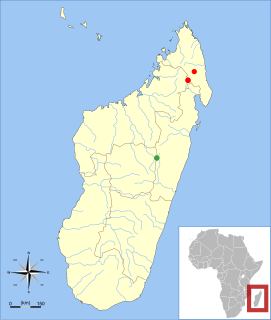
The northern voalavo, also known as the naked-tailed voalavo or simply the voalavo, is a rodent in the family Nesomyidae found in the highlands of northern Madagascar. Discovered in 1994 and formally described in 1998, it is the type species of the genus Voalavo; its closest relative is the eastern voalavo of the Central Highlands. DNA sequencing suggests that it may be more closely related to Grandidier's tufted-tailed rat than to other species of the closely related genus Eliurus. The northern voalavo is found at 1,250 to 1,950 m above sea level in montane wet and dry forests in the Marojejy and Anjanaharibe-Sud massifs. Nocturnal and solitary, it lives mainly on the ground, but it can climb and probably eats plant matter. Despite having a small range, the species is classified as being of least concern because it lacks obvious threats and much of its range is within protected areas.

Hydrachnidia, also known as "water mites", Hydrachnidiae, Hydracarina or Hydrachnellae, are among the most abundant and diverse groups of benthic arthropods, composed of 6,000 described species from 57 families. As water mites of Africa, Asia, and South America have not been well-studied, the numbers are likely to be far greater. Other taxa of parasitengone mites include species with semi-aquatic habits, but only the Hydracarina are properly subaquatic. Water mites follow the general parasitengona life cycle, which is characterized by parasitic, calyptostatic, and predaceous stages. They are ubiquitous in nearly all freshwater habitats of every continent except Antarctica. Typical habitats include streams and marshes, but may also be found in more obscure areas such as treeholes, hot springs, deep lakes and waterfalls. Some species have also adapted to marine environments. Water mites are unusual among freshwater invertebrates in being colorful, with brilliant reds and oranges being most obvious, but they also display more subtle blues, greens and yellows. They are also unusual among all mites in that some lineages have movable, internalized eye lenses sunk deep within the tissues of the prosoma rather than being set on the surface of the cuticle.

Sarcoptoidea is a superfamily of mites, including many associated with mammals.
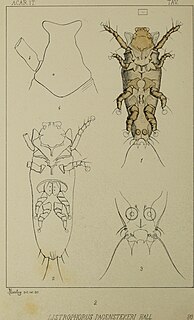
Listrophoridae is a family of mites in the suborder Psoroptidia of the order Sarcoptiformes. The family contains small, long mites specialized for grasping the hairs of mammals. North American genera include:
Prolistrophorus bakeri is a parasitic mite in the genus Prolistrophorus. Together with the Argentine P. hirstianus, it forms the subgenus Beprolistrophorus. P. bakeri has been found on the hispid cotton rat, marsh rice rat, and cotton mouse in Georgia, South Carolina, Texas, and Florida and on Oryzomys couesi in Colima. It was formerly placed in the genus Listrophorus.
Prolistrophorus grassii is a parasitic mite in the genus Prolistrophorus. It was described as Listrophorus grassii in 1954 from the marsh rice rat in Georgia. In 1974, Fain and Hyland placed it in Prolistrophorus and in 1984, Fain and Lukoschus redescribed the species on the basis of collections from the marsh rice rat in Georgia, Alabama, and Florida and the southern bog lemming in Indiana, West Virginia, and Iowa.

Phoresis or phoresy is a non-permanent, commensalistic interaction in which one organism attaches itself to another solely for the purpose of travel. Phoresis has been observed directly in ticks and mites since the 1700s and indirectly in fossils 320 million years old, but is not restricted to arthropods or animals. Plants with seeds that disperse by attaching themselves to animals are also considered to be phoretic.
Protelean organisms are widely regarded as a special class of parasites, often referred to as parasitoids. Protelean parasites refer to insects that begin the juvenile phase of their lives as parasites and ultimately destroy or consume their host to emerge as free-living adults. Defining attributes of Protelean parasitoids include a parasitic nature that is confined to the larval stage, destruction of a single host, and an independent mature stage. Other distinguishing characteristics include a body size similar to its host and a comparatively simple life style. Parasitoids and their hosts are typically in the same taxonomic class.

Chaetodactylidae is a family of mites in the order Sarcoptiformes. There are five genera: Sennertia, Chaetodactylus, Achaetodactylus, Centriacarus, and Roubikia.

Glycyphagus is a genus of astigs in the family Glycyphagidae. There are about five described species in Glycyphagus.
